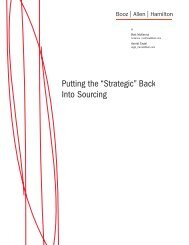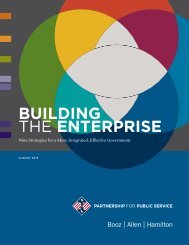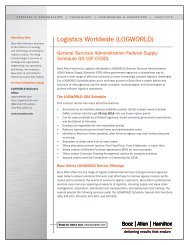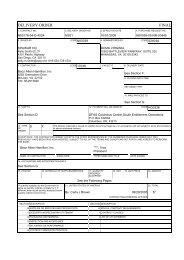Merger Integration: Delivering on the Promise - Booz Allen Hamilton
Merger Integration: Delivering on the Promise - Booz Allen Hamilton
Merger Integration: Delivering on the Promise - Booz Allen Hamilton
Create successful ePaper yourself
Turn your PDF publications into a flip-book with our unique Google optimized e-Paper software.
<strong>Booz</strong> •<strong>Allen</strong> Client Case Study: Keeping Transacti<strong>on</strong> and Value Creati<strong>on</strong> Teams Separate<br />
Client Situati<strong>on</strong><br />
Two leaders in <strong>the</strong> medical products and services industry announced <strong>the</strong>ir decisi<strong>on</strong> to merge. The companies had<br />
very different operating models and had been pursuing distinctly different strategies.<br />
Acti<strong>on</strong>s Taken<br />
The use of integrati<strong>on</strong> teams allowed <strong>the</strong> company to dedicate resources to <strong>the</strong> merger while keeping <strong>the</strong><br />
businesses running.<br />
• Line managers maintained <strong>the</strong>ir focus <strong>on</strong> day-to-day operati<strong>on</strong>s.<br />
• Full- and part-time integrati<strong>on</strong> teams performed <strong>the</strong> pre- and post-merger work.<br />
<str<strong>on</strong>g>Integrati<strong>on</strong></str<strong>on</strong>g> teams were set up outside <strong>the</strong> normal organizati<strong>on</strong>al structure to remove <strong>the</strong>m from undue influence.<br />
Results<br />
<str<strong>on</strong>g>Integrati<strong>on</strong></str<strong>on</strong>g> teams were able to produce better soluti<strong>on</strong>s to <strong>the</strong> post-merger problems than line management could<br />
have, because:<br />
• The multidisciplinary approach ensured that all functi<strong>on</strong>al voices were heard.<br />
• Teams were often given freedom to review even <strong>the</strong> sacred cows of <strong>the</strong> organizati<strong>on</strong>s.<br />
• The integrati<strong>on</strong> teams had an objective way of determining <strong>the</strong> best soluti<strong>on</strong> for <strong>the</strong> merger of such<br />
different organizati<strong>on</strong>s.<br />
Pulling It All Toge<strong>the</strong>r<br />
In our experience, <strong>the</strong> most<br />
successful merger integrati<strong>on</strong>s<br />
begin with a clear and<br />
broadly communicated game<br />
plan that addresses each of<br />
<strong>the</strong> four principles we’ve just<br />
outlined (see Exhibit 12). This<br />
game plan is inspired by <strong>the</strong><br />
shared visi<strong>on</strong> articulated at <strong>the</strong><br />
time of <strong>the</strong> merger announcement<br />
and <strong>the</strong> type of integrati<strong>on</strong><br />
anticipated, whe<strong>the</strong>r it is absorpti<strong>on</strong><br />
or a uni<strong>on</strong> of equals.<br />
Based <strong>on</strong> this visi<strong>on</strong> and<br />
approach, <strong>the</strong> game plan will<br />
need to address <strong>the</strong> inevitable<br />
organizati<strong>on</strong>al issues that will<br />
surface. How will <strong>the</strong> two<br />
companies work toge<strong>the</strong>r? Will<br />
new business units be formed?<br />
Where will <strong>the</strong> central core or<br />
headquarters operati<strong>on</strong> be located<br />
and how will it be staffed? What<br />
services will be outsourced and/or<br />
rati<strong>on</strong>alized? These are am<strong>on</strong>g<br />
<strong>the</strong> explicit choices and tradeoffs<br />
that need to be resolved at<br />
<strong>the</strong> outset of <strong>the</strong> merger integrati<strong>on</strong><br />
process.<br />
This <strong>on</strong>going organizati<strong>on</strong>al<br />
model will influence to a<br />
great degree how <strong>the</strong> actual integrati<strong>on</strong><br />
implementati<strong>on</strong> unfolds.<br />
Guided by <strong>the</strong> principles we’ve<br />
just discussed, companies will<br />
make fur<strong>the</strong>r rounds of choices<br />
about business and management<br />
processes, organizati<strong>on</strong>al structure,<br />
and support systems.<br />
These four key principles<br />
will dictate a series of transformati<strong>on</strong>al<br />
priorities that will, in<br />
turn, shape <strong>the</strong> <strong>on</strong>going game<br />
plan and <strong>the</strong> categorizati<strong>on</strong> of<br />
day <strong>on</strong>e versus l<strong>on</strong>ger-term tasks.<br />
This is an iterative process. If<br />
senior management sticks to it<br />
with rigor and clearly communicates<br />
evolving expectati<strong>on</strong>s, <strong>the</strong>re<br />
is a str<strong>on</strong>g likelihood that <strong>the</strong>y<br />
can realize <strong>the</strong> promise <strong>the</strong>y<br />
identified <strong>on</strong> <strong>the</strong> day of <strong>the</strong> merger<br />
announcement and keep all <strong>the</strong>ir<br />
c<strong>on</strong>stituencies — customers,<br />
shareholders, employees, and<br />
o<strong>the</strong>rs — more than satisfied.<br />
14
















